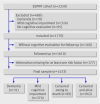Designing prevention programmes to reduce incidence of dementia: prospective cohort study of modifiable risk factors
- PMID: 20688841
- PMCID: PMC2917002
- DOI: 10.1136/bmj.c3885
Designing prevention programmes to reduce incidence of dementia: prospective cohort study of modifiable risk factors
Abstract
Objective: To estimate the percentage reduction in incidence of dementia that would be obtained if specific risk factors were eliminated.
Design: Prospective seven year cohort study.
Setting: General population, Montpellier, France.
Participants: 1433 people aged over 65 with a mean baseline age of 72.5 (SD 5.1) years.
Main outcome measures: Diagnosis of mild cognitive impairment or dementia established by a standardised neurological examination.
Results: Cox models were constructed to derive hazard ratios and determine confounding and interaction effects for potentially modifiable risk factors for dementia. Mean percentage population attributable fractions were calculated with 95% confidence intervals derived from bootstrapping for seven year incidence of mild cognitive impairment or dementia. The final model retained crystallised intelligence (population attributable fraction 18.11%, 95% confidence interval 10.91% to 25.42%), depression (10.31%, 3.66% to 17.17%), fruit and vegetable consumption (6.46%, 0.15% to 13.06%), diabetes (4.88%, 1.87% to 7.98%), and apolipoprotein E epsilon4 allele (7.11%, 2.44% to 11.98%).
Conclusions: Increasing crystallised intelligence and fruit and vegetable consumption and eliminating depression and diabetes are likely to have the biggest impact on reducing the incidence of dementia, outweighing even the effect of removing the principal known genetic risk factor. Although causal relations cannot be concluded with certainty, the study suggests priorities that may inform public health programmes.
Conflict of interest statement
Competing interests: All authors have completed the Unified Competing Interest form at
Comment in
-
Can dementia be prevented?BMJ. 2010 Aug 5;341:c4201. doi: 10.1136/bmj.c4201. BMJ. 2010. PMID: 20688836 No abstract available.
-
Preventing dementia. Targeting depressive symptoms is unlikely to help.BMJ. 2010 Sep 7;341:c4697. doi: 10.1136/bmj.c4697. BMJ. 2010. PMID: 20823016 No abstract available.
-
Preventing dementia. Bridging theory and reality gap.BMJ. 2010 Sep 7;341:c4698. doi: 10.1136/bmj.c4698. BMJ. 2010. PMID: 20823017 No abstract available.
References
-
- Gao S, Hendrie HC, Hall KS, Hui S. The relationship between age, sex and the incidence of dementia and Alzheimer disease: a meta-analysis. Arch Gen Psychiatry 1998;55:809-15. - PubMed
-
- Lautenschlager NT, Cupples LA, Rao VS, Auerbach SA, Becker R, Burke J, et al. Risk of dementia among relatives of Alzheimer’s disease patients in the MIRAGE study: what is in store for the oldest old? Neurology 1996;46:641-50. - PubMed
-
- Ritchie K, Kildea D. Is senile dementia age-related or ageing-related? Evidence from a meta-analysis of dementia prevalence in the oldest old. Lancet 1995;346:931-4. - PubMed
-
- Stern Y, Alexander GE, Prohovnik I, Mayeux R. Inverse relationship between education and parietotemporal perfusion deficit in Alzheimer’s disease. Ann Neurol 1992;32:371-5. - PubMed
Publication types
MeSH terms
LinkOut - more resources
Full Text Sources
Other Literature Sources
Medical

